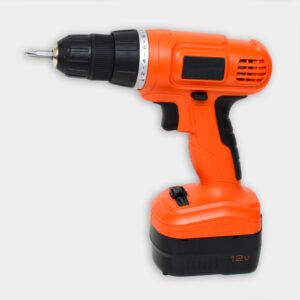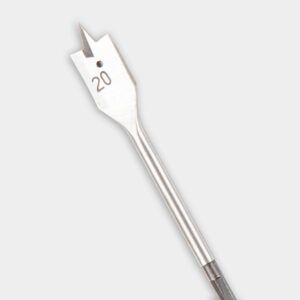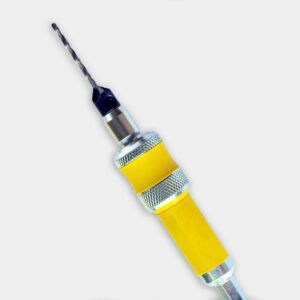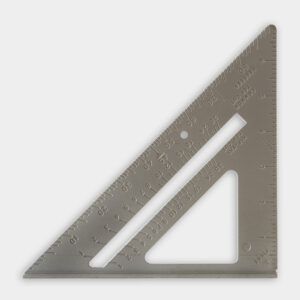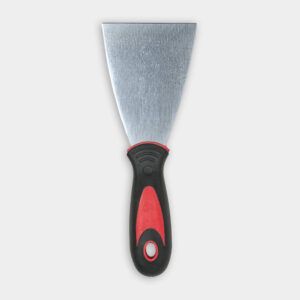We may be compensated if you purchase through links on our website. Our team is committed to delivering honest, objective, and independent reviews on home products and services.
Project details
Skill
Cost
Estimated Time
A wobbly newel post is a common issue that can make your staircase unstable or unsafe. Luckily, repairing a loose newel post is a straightforward DIY project that can be completed in just under two hours with basic tools and materials. In the video above, This Old House general contractor Tom Silva demonstrates an effective method to secure a shaky post using a single screw.
Newel Post Construction
Newel posts are important pieces of a staircase and provide support for handrails, increasing the overall stability for those going up and down. Before attempting repairs, it’s helpful to understand how these posts are typically built.
Types of Newel Posts
There are two main kinds of newel posts:
- Solid wood posts: Made from a single piece of wood
- Hollow posts: Constructed from four individual pieces of wood
In the video, Silva identifies the newel post as hollow by noticing a visible joint running up the side. This detail affects which repair approach he takes, since hollow posts need internal support to create a firm reattachment.
Common Causes of Loose Newel Posts
Several things can lead to a newel post becoming loose over time:
- Regular use and wear
- Poor initial installation
- Loosening of nails or fasteners
- Structural shifts in the staircase
Understanding these helps you address the root of the problem. Newel posts may become loose due to the repeated pressure applied when people use the handrail for balance or support. Environmental factors like humidity and temperature fluctuations can also cause the wood to expand and contract, weakening the attachment points over time.
Why It’s Important to Fix a Loose Newel Post
A loose newel post not only poses a safety risk but also affects the look and structural integrity of your staircase. It’s good to take care of it quickly, especially if you have children or elderly family members who rely on the handrail for support.
Preparing to Repair the Newel Post
Before beginning, get the necessary tools and materials to avoid interruptions and make sure you have everything needed to complete the project smoothly and efficiently.
Tools and Materials Needed
- Drill/driver
- Drill bits (twist and spade)
- Drill bit extensions
- Speed/Layout square
- Putty knife
- Wood putty
- Long screw (engineered lumber fastener)
- Temporary wood brace
- Wood glue
- Safety glasses
Safety Precautions
When working on staircase repairs, always prioritize safety by doing the following:
- Wear safety glasses to protect your eyes from wood dust and debris
- Use caution when operating power tools
- Make sure the work area is well-lit and free from tripping hazards
- Have a helper nearby to assist with bracing and stabilizing the newel post
- Double-check that your tools are in good working condition to avoid accidents during the repair
Step-by-Step Newel Post Repair Process
Follow these steps to tighten your loose newel post.
Stabilize the Newel Post
Begin by temporarily securing the newel post to prevent movement during the repair process:
- Wedge a temporary wood brace between the nearest wall and the newel post.
- Use a block of wood against the trim to prevent damage.
- Adjust the brace to hold the post tight against the stair tread.
This step makes sure the post remains in the correct position during the repair process. A stable newel post makes it easier to drill accurate holes and make the final fastening as effective as possible. You might need a helper for this step to guide the wood with you.
Drill the Pilot Holes
Drilling at the correct height and angle is crucial to make sure the screw hits the center of the tread without protruding. This prevents splitting the wood and keeps the screw holding the post firmly in place.
- Use a 3/4-inch spade bit to create a ¼-inch deep counterbore hole in the post.
- Drill a screw-shank clearance hole through the post using a standard-length drill bit.
- Switch to an extra-long bit to extend the hole just into the stair tread.
- Use a smaller bit to create a pilot hole in the stair tread for the screw threads.
Install the Fastener
With the holes prepared, it’s time to secure the post:
- Select a long screw designed for engineered lumber, featuring a T-head and threaded end.
- Drive the screw through the prepared holes into the stair tread.
- Tighten the screw until the newel post is firmly secured.
A well-installed fastener should keep the newel post in place for years. Check that the screw is tight but not over-tightened, as this can strip the wood and compromise the repair.
Finish the Repair
Complete the job with these finishing touches:
- Remove the temporary brace.
- Fill the counterbore hole with wood putty.
- Allow the putty to dry, then apply a second coat if necessary.
- Once fully dry, sand the area until smooth.
- Prime and paint the filled area to match the newel post.
In the video, Silva reattaches the newel cap using wood glue for a complete repair. These finishing touches guarantee that the repair is not only structurally sound but also looks good.
Troubleshooting Common Issues When Repairing a Newel Post
Even with careful preparation, you may run into some challenges during the repair process. Here are common issues and how to address them:
Misaligned Holes
If the drilled holes don’t align correctly:
- Double-check your measurements and marking before drilling.
- Use a layout square to get your drill level and straight.
- Consider drilling a new set of holes if necessary.
Misalignment can affect the stability of the newel post. Taking the time to measure accurately and use the right tools can prevent this issue.
Stripped Screw Holes
In case of stripped screw holes:
- Use a larger diameter screw.
- Fill the hole with wood filler or toothpicks and wood glue, allow to dry, then redrill.
- Consider using a wood epoxy for severe cases.
Stripped screw holes can mess up your repair, causing the newel post to become loose again. Using a larger screw or reinforcing the hole with wood filler helps create a tighter grip.
Split Wood
Splitting can happen when drilling or driving screws into the wood:
- Use a smaller pilot hole to reduce the risk of splitting.
- Apply masking tape around the drill area to minimize wood damage.
- Drill slowly and steadily, applying even pressure.
Taking these precautions during the drilling process can help you avoid splitting the wood, which would create a whole new set of problems.
Maintaining Your Repaired Newel Post
After successfully repairing your newel post, good upkeep can prevent future issues.
Regular Inspections
Do these periodic checks of your newel post:
- Test for any wobbling or movement
- Inspect for signs of wear or damage
- Check the tightness of any visible fasteners
Regular inspections help identify potential issues early on, allowing you to address them before they become more severe. Check that all fasteners are tight.
Preventive Measures
Take these steps to keep your newel post sturdy over time:
- Avoid excessive force when using the handrail
- Address any staircase structural issues quickly
- Apply a protective finish to wooden posts to prevent moisture damage
These measures help keep the integrity of your repaired newel post.
Protecting Wooden Posts
Wooden posts require additional care to maintain their durability. Consider doing the following:
- Apply a sealant to protect against moisture to preserve the post’s long-term appearance
- Clean regularly to prevent dirt buildup, which can cause damage over time
- Reapply protective finishes as needed to keep the wood in good condition and looking fresh
